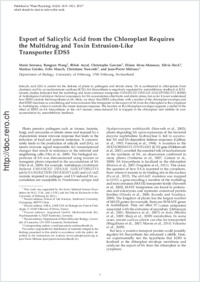export of salicylic acid from the chloroplast requires the multidrug and toxin extrusion-Like transporter EDS5
- Serrano, Mario Department of Biology, University of Fribourg, Switzerland
- Wang, Bangjun Department of Biology, University of Fribourg, Switzerland - School of Life Sciences, Southwest University, Chongqing, China
- Aryal, Bibek Department of Biology, University of Fribourg, Switzerland
- Garcion, Christophe Department of Biology, University of Fribourg, Switzerland - INRA, UMR 1332 de Biologie du Fruit et Pathologie, Villenave d’Ornon, France.
- Abou-Mansour, Eliane Department of Biology, University of Fribourg, Switzerland
- Heck, Silvia Department of Biology, University of Fribourg, Switzerland - Angiomed GmbH, Medizintechnik KG,Karlsruhe, Germany.
- Geisler, Markus Department of Biology, University of Fribourg, Switzerland
- Mauch, Felix Department of Biology, University of Fribourg, Switzerland
- Nawrath, Christiane Department of Biology, University of Fribourg, Switzerland - Department of Plant Molecular Biology, University of Lausanne, Switzerland.
- Métraux, Jean-Pierre Department of Biology, University of Fribourg, Switzerland
-
01.08.2013
Published in:
- Plant Physiology. - 2013, vol. 162, no. 4, p. 1815–1821
English
Salicylic acid (SA) is central for the defense of plants to pathogens and abiotic stress. SA is synthesized in chloroplasts from chorismic acid by an isochorismate synthase (ICS1); SA biosynthesis is negatively regulated by autoinhibitory feedback at ICS1. Genetic studies indicated that the multidrug and toxin extrusion transporter ENHANCED DISEASE SUSCEPTIBILITY5 (EDS5) of Arabidopsis (Arabidopsis thaliana) is necessary for SA accumulation after biotic and abiotic stress, but so far it is not understood how EDS5 controls the biosynthesis of SA. Here, we show that EDS5 colocalizes with a marker of the chloroplast envelope and that EDS5 functions as a multidrug and toxin extrusion-like transporter in the export of SA from the chloroplast to the cytoplasm in Arabidopsis, where it controls the innate immune response. The location at the chloroplast envelope supports a model of the effect of EDS5 on SA biosynthesis: in the eds5 mutant, stress-induced SA is trapped in the chloroplast and inhibits its own accumulation by autoinhibitory feedback.
- Faculty
- Faculté des sciences et de médecine
- Department
- Département de Biologie
- Language
-
- English
- Classification
- Biological sciences
- License
- License undefined
- Identifiers
-
- RERO DOC 32962
- DOI 10.1104/pp.113.218156
- Persistent URL
- https://folia.unifr.ch/unifr/documents/303391
Other files
Statistics
Document views: 76
File downloads:
- met_esa.pdf: 161
- met_esa_sm.pdf: 68

